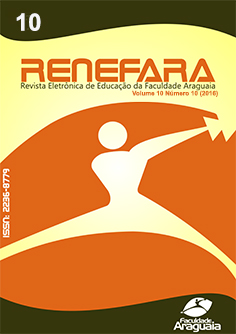IMPORTÂNCIA DAS AULAS PRÁTICAS NA DISCIPLINA DE ANATOMIA VEGETAL, CURSO DE EXTENSÃO: DESCRIÇÃO DA ANATOMIA FOLIAR E HISTOQUIMICA DE Plectranthus barbatus Andrews (LAMIACEAE)
Keywords:
Testes histoquímicos, descrição lâmina foliar, metabólitos, boldo.Abstract
Vários alunos vêm demonstrando desinteresse pelo ensino de Botânica, sobretudo os de graduação, o que têm preocupado muitos professores dessa área. Despertar nos alunos, o interesse pela Botânica tem sido um desafio. Com o intuito de motivar e despertar o interesse dos alunos pelo ensino da Botânica propôs-se um curso de extensão na Faculdade Araguaia, Goiânia, Goiás, intitulado: "Conhecendo as plantas por dentro, mitos e realidades", durante o curso, foi sugerido aos alunos a realização de um trabalho de botânica, que envolvesse a análise anatômica e histoquímica de uma planta medicinal. O boldo (Plectranthus barbatus) foi à planta medicinal escolhida pelos alunos. Para as observações anatômicas, foram realizadas oficinas de técnicas usuais de anatomia vegetal. Dentre as técnicas, os testes histoquímicos foram utilizados a fim de evidenciar possíveis metabolitos secundários. A análise anatômica de P. barbatus permitiu observar que a lâmina foliar apresenta epiderme uniestratificada recoberta por cutícula delgada e estriada.Os estômatos diaciticos foram predominantes na face abaxial.Presença de tricomas tectores simples unisseriados uni a pluricelulares; glandulares peltados e capitados em ambas as faces, com maior abundância na face abaxial.O mesofilo isodiamétrico. A nervura principal apresenta contorno biconvexo, com feixes vasculares colaterais envoltos por endoderme. O bordo apresenta forma arredondada. Os principais compostos detectados foram: lipídios totais, compostos fenólicos, óleos essenciais e amido. Os resultados do trabalho foram mostrados a comunidade acadêmica através da elaboração de um pôster e apresentação em evento científico. Os alunos relataram que as estratégias utilizadas possibilitaram o aprendizado de uma maneira mais eficaz e prazerosa.
Downloads
Published
Issue
Section
License
The copyright of the published articles will be transferred to the Uniaaraguaia Magazine, allowing its subsequent reproduction as transcription and with due citation of source. In the event of acceptance and before the publication of the article, the plaintiff (s) shall write a statement formally transferring copyright to the magazine.
The author may also print and distribute copies of his article, provided that he mentions that the rights belong to the Uniaaraguaia Magazine.
Author rights include the right to reproduce in full or partly by any means, distribute this article, including figures and photographs.
By submitting originals to the Uniaaraguaia magazine, the author or authors express agreement with the following terms:
a) Authors maintain copyright and grant Uniaraguaia magazine the right of first publication, with the work simultaneously licensed under the Creative Commons Attribution license that allows the sharing of work with recognition of the authorship and initial publication in this magazine.
b) Authors are authorized to assume additional contracts separately, for non-expiration distribution of the work version published in this magazine (eg publish in institutional repository or as book chapter), with recognition of authorship and initial publication in this journal.
c) Authors are allowed and are encouraged to publish and distribute their work online (eg in institutional repositories or on their personal page) to any point before or during the editorial process, as this can generate productive changes as well as increase the impact and citation of published work.

